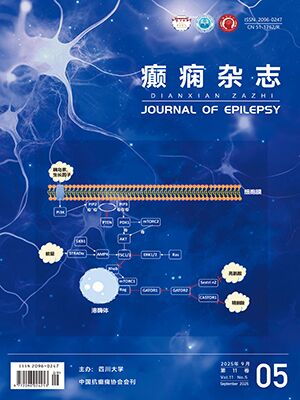| 1. |
Potschka H, Trinka E. Perampanel: does it have broad-spectrum potential? Epilepsia, 2019, 60(Suppl 1): 22-36.
|
| 2. |
Sills GJ, Rogawski MA. Mechanisms of action of currently used antiseizure drugs . Neuropharmacology, 2020, 168(5): 107966.
|
| 3. |
刘晓燕. 临床脑电图学(第2版). 北京: 人民卫生出版社, 2017: 335.
|
| 4. |
Yamamoto T, Gil-Nagel A, Wheless JW, et al. Perampanel monotherapy for the treatment of epilepsy: clinical trial and real-world evidence. Epilepsy Behav, 2022, 136: 108885.
|
| 5. |
梁锦平. 国际抗癫痫联盟2017年版癫痫分类特点及其解读 . 中国实用儿科杂志, 2020, 35(1): 47-54.
|
| 6. |
French JA, Krauss GL, Biton V, et al. Adjunctive perampanel for refractory partial-onset seizures: randomized phase III study 304. Neurology, 2012, 79(6): 589–596.
|
| 7. |
French JA, Krauss GL, Steinhoff BJ, et al. Evaluation of adjunctive perampanel in patients with refractory partial-onset seizures: results of randomized global phase III study 305. Epilepsia, 2013, 54(1): 117–125.
|
| 8. |
Krauss GL, Serratosa JM, Villanueva V, et al. Randomized phase III study 306: adjunctive perampanel for refractory partial-onset seizures. Neurology, 2012, 8(18): 1408–1415.
|
| 9. |
Gil-Nagel A, Burd S, Toledo M, et al. A retrospective, multicentre study of perampanel given as monotherapy in routine clinical care in people with epilepsy. Seizure, 2018, 54: 61–66.
|
| 10. |
Husni RE, Ngo LY, Senokuchi H, et al. Experience of perampanel monotherapy beyond initial titration to achieve seizure freedom in patients with focal-onset seizures with newly diagnosed or currently untreated recurrent epilepsy: a post hoc analysis of the open-label study 342 (FREEDOM). Epilepsia Open, 2022, 7(1): 59–66.
|
| 11. |
樊海珍, 王燕梅, 韩虹, 等. PER添加治疗儿童局灶性癫痫疗效与安全性观察. 中国药物与临床, 2021, 21(14): 2524-2526 .
|
| 12. |
Brodie MJ, Stephen LJ. Prospective audit with adjunctive perampanel: preliminary observations in focal epilepsy. Epilepsy Behav, 2016, 54: 100-103.
|
| 13. |
Garamendi-Ruiz I, García-García ME, Bertol-Alegre V, et al. One-year clinical experience of perampanel in Spain: a multicentre study of efficacy and tolerability. Epileptic Disord, 2016, 18: 173-180.
|
| 14. |
Maurousset A, Limousin N, Praline J, et al. Adjunctive perampanel in refractory epilepsy: experience at tertiary epilepsy care center in Tours . Epilepsy Behav, 2016, 61: 237-241.
|
| 15. |
Villanueva V, GarcésM, López-González FJ, et al. Safety, efficacy and outcome-related factors of perampanel over 12 months in a real-world setting: the FYDATA study. Epilepsy Res, 2016, 126: 201-210.
|
| 16. |
Heyman E, Lahat E, LeVin N, et al. Tolerability and efficacy of perampanel in children with refractory epilepsy. Dev Med Child Neurol, 2017, 59: 441-444.
|
| 17. |
Datta AN, Xu Q, Sachedina S, et al. Clinical experience with perampanel for refractory pediatric epilepsy in one Canadian center. J Child Neurol, 2017, 32: 834-839.
|
| 18. |
Swiderska N, Tan HJ, Rajai A, et al. Effectiveness and tolerability of perampanel in children, adolescents and young adults with refractory epilepsy: a UK national multicentre study. Seizure, 2017, 52: 63-70.
|
| 19. |
Biró A, Stephani U, Tarallo T, et al. Effectiveness and tolerability of perampanel in children and adolescents with refractory epilepsies: first experiences. Neuropediatrics, 2015, 46: 110-115.
|
| 20. |
De Liso P, Vigeano F, Specchio N, et al. Effectiveness and tolerability of perampanel in children and adolescents with refractory epilepsies: an Italian observational multicenter study. Epilepsy Res, 2016, 127: 93-100.
|
| 21. |
Stein hoff BJ, Hamer H, Trinka E, et al. A multi-center survey of clinical experiences with perampanel in real life in Germany and Austria. Epilepsy Res, 2014, 108(5): 986-988.
|




